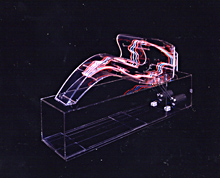3a
ネオ・ダダイズム・オルガナイザーズ
Neo Dadaism Organizers
【本文確定】
1959年の第11回読売アンデパンダン展から、「不穏なガラクタ・オブジェ」のたぐいが目立ってきました。全体の傾向を瀧口修造は次のように記しています。「たとえば会場の印象を抽象絵画が圧倒的だといったとしたら、そうした評語はもはや古典的でほとんど意味をなさないような作品が多くなっている。(中略)これをいわゆる『アンフォルメル』の影響という風に見ることもできようが、それだけでは解決のつかないものがあるだろう」。そして、「一つ極端な例をあげよう」として続けられた文章は以下の通りでした。「彫刻室の篠原有司男の廃棄遺物を積み束ねたような出品物には『こうなったら、やけくそだ!』と題してある。(中略)これはたしかに類のない『わるい彫刻』の一つとして記録に値いしようが、だれもこの作家の未来を予言するものはいないだろう、私はひやかしているのではない。アンデパンダンはこれを避けて通ることができないことをいいたいのだ」*3a1 *3a2。
アンデパンダン作家第2世代は第11回展でほぼ出そろい、その中からネオ・ダダのグループが発生しました。吉村益信を中心とするグループにモヒカン刈りの篠原有司男が合流して、1960年3月、第12回読売アンデパンダン展初日の晩、「ネオ・ダダイズム・オルガナイザーズ」の結成が宣言されました*3a3。メンバーは吉村益信、篠原有司男、赤瀬川原平[赤瀬川克彦]、荒川修作、石橋別人[石橋清治]、風倉匠[風倉省作]、豊島壮六ほか。工藤哲巳と三木富雄は常に行動を共にしていましたが、加わろうとはしませんでした。
1960年4月、東京の銀座画廊で第1回ネオ・ダダイズム・オルガナイザーズ展が開催され、篠原有司男がマニフェストを起草しました。「一九六〇年の生殖をいかに夢想しようとも、一発のアトムが気軽に解決してくれるように、ピカソの闘牛もすでにひき殺された野良猫の血しぶきほどに、我々の心を動かせない。真摯な芸術作品をふみつぶして行く二〇・六世紀の真赤にのぼせあがった地球に登場して我々が虐殺をまぬがれる唯一の手段は殺戮者にまわることだ」*3a4。
このとき篠原有司男は画廊の中空に300個のゴム風船を群がらせ、上田純は豆腐の上でもやしを栽培しました。石橋別人は、車道に8分間放置してタイヤ跡をつけたケント紙を展示し、その前で座禅を組みました。そして、画廊内のあらゆる物を叩き壊しながら録音した音が画廊の窓から街頭に向けて放送され、吉村益信は展覧会ポスターを全身にミイラのようにぐるぐる巻いて銀座の路頭にさまよい出ました。同じ頃、国会議事堂の周辺では日米安全保障条約の改定に反対する「60年安保闘争」が大々的に繰り広げられていましたが、ネオ・ダダのグループもそのデモに参加し、ただし「安保反対」ではなく「アンフォ反対」と叫びました。アンフォルメルに対する揶揄でした。
同1960年7月、東京新宿の吉村益信のアトリエ(通称「革命芸術家のホワイトハウス」)で開かれた第2回展では、彼らは単に「ネオ・ダダ」と自称し、岸本清子、田辺三太郎、田中信太郎、吉野辰海がメンバーに加わりました。9月、鎌倉材木座海岸で「ビーチ・ショー」を開催。同月、東京の日比谷公園内にある日比谷画廊の屋内外で第3回展ネオ・ダダ展を開催。美術作品らしいものは一切ありませんでしたが、グループは展覧会の有無にかかわらず連日マスコミの取材を受け、群がるカメラ陣を前にアナーキーで破廉恥で破壊的なハプニングを繰り返しました。
ただひとり荒川修作がセメントと綿の死体のオブジェで個展を開きましたが(9月、東京の村松画廊)、美学的でありグループ行動を乱したとして、彼はグループから除名されました。グループの破壊衝動はさらに「東京都美術館爆破計画」が練られるまでに高まりましたが*3a5 *3a6、吉村益信の突然の結婚によって、結成後一年に満たぬままグループは事実上「蒸発」したとされます。
From the 11th Yomiuri Independent Exhibition in 1959, exhibits like "Disquieting Junk Objects" became prominent. TAKIGUCHI Shuzo 瀧口修造 wrote as follows: "If you described the impression of the exhibition as being dominated by abstract paintings, it would make little sense because an increasing number of works have made such a comment too archaic...... Although we can understand this situation as an influence of the so-called 'art informel,' this explanation still misses something unsolved." Begining with "Let me give an extreme example," he followed "SHINOHARA Ushio 篠原有司男's exhibit at the sculpture room which looked like a pile of junk was titled 'I Don't Give a Damn Anymore!'...... Although it is worthy of being recorded as a surely unprecedented 'bad sculpture,' nobody would predict the future of this artist. I'm not making a sarcasm, but stating that the Independent Exhibition cannot avoid this*3a1."
At the 11th Exhibition, almost all of the new artists to be the second generation of the Independent Exhibition artists were present there*3a2, among which the Neo Dada group emerged out. SHINOHARA Ushio 篠原有司男, who sported a Mohican hairstyle, joined the group led by YOSHIMURA Masunobu 吉村益信, bringing about declaration of the founding of "Neo Dadaism Organizers" in the first night of the 12th Yomiuri Independent Exhibition in March 1960*3a3. The members were YOSHIMURA Masunobu 吉村益信, SHINOHARA Ushio 篠原有司男, AKASEGAWA Genpei 赤瀬川原平 [AKASEGAWA Katsuhiko 赤瀬川克彦], ARAKAWA Shusaku 荒川修作, KAZAKURA Sho 風倉匠 [KAZAKURA Shosaku 風倉省作], ISHIBASHI Waketo 石橋別人 [ISHIBASHI Kiyoshi 石橋清治], TOYOSHIMA Soroku 豊島壮六 and others. Although KUDO Tetsumi 工藤哲巳 and MIKI Tomio 三木富雄 always took part in their movements, they refused to join the group.
In April 1960, the 1st Neo Dadaism Organizers Exhibition was held at Ginza Gallery in Tokyo, whose manifesto was drafted by SHINOHARA Ushio 篠原有司男: "No matter how you may dream about sexual reproduction in 1960, as a single shot of atom will readily solve it, even Picasso's bullfight cannot move our heart, any deeper than blood spray of a stray cat run over to death. Having emerged in the madly red-hot earth of the 20.6th century that tramples down serious works of art, the only way for us to avoid being massacred is to take charge of becoming slaughterers."
At this exhibition, SHINOHARA Ushio 篠原有司男 made 300 rubber balloons swarm in the air of the gallery, and UEDA Jun 上田純 cultivated bean sprouts on tofu. ISHIBASHI Waketo 石橋別人 displayed a sheet of Kent paper on which he made tire stamps by leaving it on the road for 8 minutes, sitting in front of it in Zen meditation style. While the sound of destroying everything in the gallery was recorded and then repeated loudly from the window to the street, YOSHIMURA Masunobu 吉村益信 wrapped his body around with posters of the exhibition like a mummy, wandering about on the streets of Ginza. Meanwhile, the Diet Building was being surrounded by the "1960 Anpo Struggle," the large-scale struggle against the revision of the US-Japan Security Treaty (Anpo), in which artists around the Neo Dada group also took part by shouting out not "Anti-Anpo" but "Anti-Anfo" (Anfo, a Japanese abbreviation of the art informel, sounds like Anpo). This was an act of bringing the art informel into ridicule.
In July of the same year 1960, they began to call themselves "Neo Dada" simply from their 2nd Exhibition at YOSHIMURA Masunobu 吉村益信's atelier in Shinjuku, Tokyo, acquiring KISHIMOTO Sayako 岸本清子, TANAKA Shintaro 田中信太郎, TANABE Santaro 田辺三太郎, and YOSHINO Tatsumi 吉野辰海 into the group. In September, they held the "beach show" at Zaimokuza Beach, Kamakura, and the 3rd Neo Dada Exhibition at both inside and outside of Hibiya Gallery in the Hibiya park, Tokyo. Although there was nothing that looked like works of art at all, the group was being covered by the mass media every day regardless of any exhibition to be held, having repeated anarchic, obscene and destructive happenings in front of the swarm of press cameras.
Only one among them, ARAKAWA Shusaku 荒川修作, held a solo exhibition showing corpse objects made of cement and cotton (in September, at Muramatsu Gallery in Tokyo). However, the group expelled him for his being aesthetic and upsetting the group action. The group's impulse for destruction increased more to such an extent that even the "Tokyo Metropolitan Art Museum Blasting Plan" was planned*3a4 *3a5. However, it is said that the sudden marriage of YOSHIMURA Masunobu 吉村益信 virtually made the group "evapolate" even before a year from its foundation had passed.



